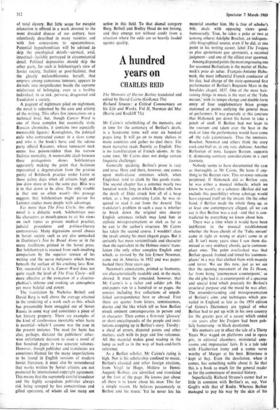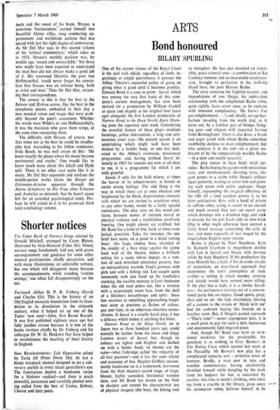A hundred years on
CHARLES REID
The Memoirs of Hector Berlioz translated and edited by David Cairns (Gollancz 75s) Richard Strauss: a Critical Commentary on his Life and Works, Vol II, Norman del Mar (Barrie and Rockliff 75s)
Mr Cairns's refurbishing of the memoirs, out in time for the centenary of Berlioz's death, is a handsome tome well over six hundred pages long. It will go on to many shelves in many countries and gather no dust there. The main narrative reads fluently as English. This is no transliteration of French idioms. At the same time, Mr Cairns does not dodge certain linguistic challenges.
Generally speaking, Berlioz's prose is racy and terse. Here and there, however, one comes upon multi-clause sentences which, when Englished, tend to clank by like goods trains. The second chapter has a sentence nearly two hundred words long in which Berlioz tells how the death of Dido struck him all of a heap when, as a boy construing Latin, he was re- quired to read it out from the Aeneid. The translator's problem in such a case is whether to break down the original into shorter English sentences (which may land him in stylistic misrepresentation) or stick as far as he can to the author's structure. Mr Cairns has taken the second course. I wouldn't class the result among his most elegant pages. But it certainly has more verisimilitude and character than the equivalent in the Holmes sisters' trans- lation (the only other complete English one) which, as revised by the late Ernest Newman, came out in America in 1932 and was paper- backed there three years ago.
Newman's annotations, printed as footnotes, are characteristically readable and, in the main, shrewd. It must be conceded, however, that Mr Cairns's is a richer and solider job. His end-papers run to a hundred or so pages, the sources including five collections of unpub- lished correspondence here or abroad. First there are quotes from letters, reminiscences, diaries and the like which tell us,how Berlioz struck eminent contemporaries in person and in character. Then comes a first-rate 'glossary' or short encyclopaedia of the people and insti- tutions cropping up in Berlioz's story. Thirdly: a sheaf of errors, disputed points and other matters, each with its page and line reference. All this material makes good reading in the lump as well as in the way of back-and-forth reference.
As a Berlioz scholar, Mr Cairns's rating is high. Nor is his scholarship confined to music. Berlioz's classical and other foreign citations, from Virgil to Hugo, Moliere to Henri- Auguste Barbier, are identified and translated at the foot of the page. He knows just about all there is to know about his man. This for a simple reason. He believes passionately in Berlioz and his music: Yet he never lets his material smother him. He is free of scholar's bile; deals with opposing views- good- humouredly. True, he takes a poke or two at 4among others) Adolphe Boschot, an indispens- able biographical source, even if he did, at one point in his writing career, label The Trokins as plus spontiniens que spontanes, a recanted judgment—and one of the silliest ever spawned.
Among disputed points the most engrossing one for seasoned Berliozians is the matter of Haba- neck's prise de tabac. Francois-Antoine Haba- 'neck, the most influential French conductor of his day, had charge of the state-sponsored first performance of Berlioz's Requiem Mass in the Invalides chapel, 1837. One of the most hair- raising things in music is the start of the 'Tuba mirum,'. with its tempo change and double-forte entry of four supplementary brass groups stationed at points outlying the general mass of performers. It was precisely at this juncture ,that Habaneck put down his baton to take a pinch of snuff. If Berlioz had not leapt to the rostrum and taken over the beat in the nick of time the performance would have come off the rails calamitously. Thus the memoirs. Boschot, Newman and others think the story cock-and-bull or, at any rate, dubious. Another Berliozian of note, Jacques Barzun, suppoits it, dismissing contrary considerations in a curt footnote.
Nobody seems to have documented the case as thoroughly as Mr Cairns. He leans if any- thing to the Barzun view. This reviewer remains perplexed. If Habaneck did as Berlioz says, he was either a musical imbecile, which we know he wasn't, or a saboteur (Berlioz did-not exclude this possibility) whose sabotage would have exposed itself on the instant. On the other hand, if Berlioz made the whole thing up, as at least one contemporary .alleged, all we can say is that Berlioz was a cad—and that is con- tradicted by everything we know about him.
There was a time when it would have been indifferent to the musical establishment whether the brass chords of the 'Tuba mirunf came in right or wrong or didn't come -in at all. It isn't many years since I saw them dis- missed as very ordinary chords, qu:te common- place ones. The point overlooked was that Berlioz spaced, framed and timed his 'common- places' in a way that clothed them with majesty .• and terror. We see this now, just as we see that the opening movement of the Te Drum, far from being 'journeyman 'counterpoint,' as the old gibe had it, is counterpoint of a spacious and special kind which precisely fits Berlioz's structural purpose and the mood he was after. The misunderstanding and misrepresentation of Berlioz's aims and techniques which pre- vailed in England as late as the 1954 edition Grove's Dictionary are typical of what Berlioz had to put up with in his own country for the greater part of a career which ended —six years after his. Trojans had been pub- licly hamstrung—in black desolation.
His memoirs are in effect the tale of a Thirty Years War waged on platforms and in opera pits, in editorial chambers, ministerial ante- rooms and impresarios' lairs. It is a tale told with Flaubertian , irony and a comic verve worthy of Murger at his best. Bitterness is a- kept at bay. Even the desolation, when it comes, has something noble about it. So that this is a book as much for the general reader as for the connoisseur of musical history.
Superficially Richard Strauss's career had as little in common with Berlioz's as, say, Van Gogh's with that of Rodin. Whereas Berlioz managed to pay his way by the skin of his tenth and the sweat of his brow, Strauss, a notorious 'businessman,' earned himself two beautiful Alpine villas, snug conducting ap- pointments and worldwide acclaim that was spiced with just the right degree of controversy. As Mr Del Mar says in this second volume of his 'critical commentary,' which takes us to 1933, Strauss's worldly position was, by middle age, `secure and unassailable.' Yet those who might have been expected to understand the man best did not always make a good job of it. His renowned librettist, the poet von Hoffmansthal, 'could never forget his convic- tion that Strauss was an inferior being, both as artist and man.' Thus Mr Del Mar, review- ing their correspondence.
The answer to this is that the best in the Salome and Elektra scores, like the best in the symphonic poems, embodied in their day a new musical vision and magic that were prob- ably beyond the poet's assessment. Whether the words were Wilde's or von HoffmansthaPs, it was the musician who gave them wings, at the same time outsoaring them.
The difficulty with Strauss, of course, was that when not at his best he could be insuffer- ably bad. According to his fellow conductor, Fritz Busch, he was well aware of this: 'He knew exactly the places where his music became sentimental and trashy.' One would like to know much more about this Jekyll and Hyde split. There is no other case quite like it in music. Mr Del Mar expounds and analyses the middle-period works (from the Burger air Edelmann-Ariadne sequence through the Alpine Symphony to Die Frau ohne Schatten and Arabella) so minutely that he hasn't space left for an extended psychological study. Per- haps he will attend to it in his promised third (and concluding) volume.



































 Previous page
Previous page